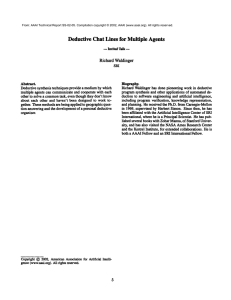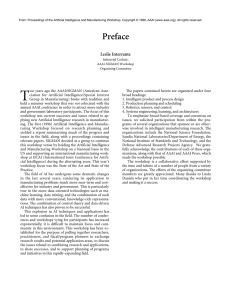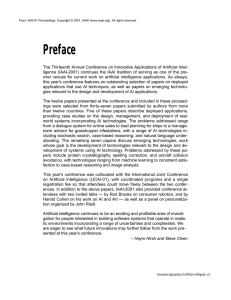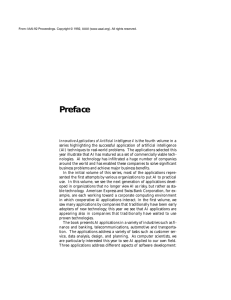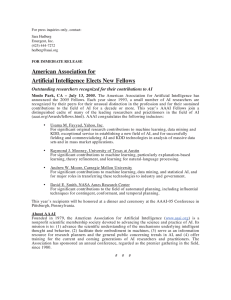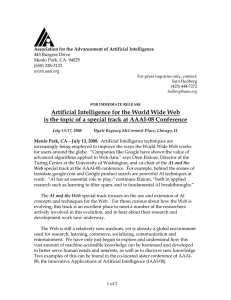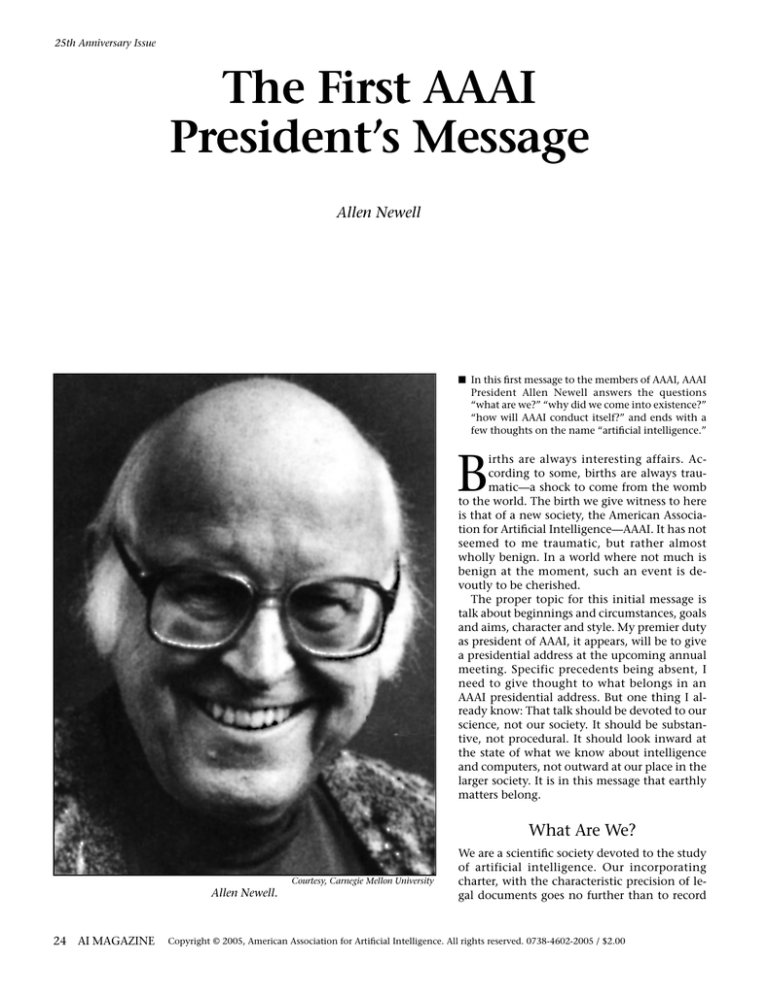
25th Anniversary Issue
The First AAAI
President’s Message
Allen Newell
■ In this first message to the members of AAAI, AAAI
President Allen Newell answers the questions
“what are we?” “why did we come into existence?”
“how will AAAI conduct itself?” and ends with a
few thoughts on the name “artificial intelligence.”
B
irths are always interesting affairs. According to some, births are always traumatic—a shock to come from the womb
to the world. The birth we give witness to here
is that of a new society, the American Association for Artificial Intelligence—AAAI. It has not
seemed to me traumatic, but rather almost
wholly benign. In a world where not much is
benign at the moment, such an event is devoutly to be cherished.
The proper topic for this initial message is
talk about beginnings and circumstances, goals
and aims, character and style. My premier duty
as president of AAAI, it appears, will be to give
a presidential address at the upcoming annual
meeting. Specific precedents being absent, I
need to give thought to what belongs in an
AAAI presidential address. But one thing I already know: That talk should be devoted to our
science, not our society. It should be substantive, not procedural. It should look inward at
the state of what we know about intelligence
and computers, not outward at our place in the
larger society. It is in this message that earthly
matters belong.
What Are We?
Courtesy, Carnegie Mellon University
Allen Newell.
24 AI MAGAZINE
We are a scientific society devoted to the study
of artificial intelligence. Our incorporating
charter, with the characteristic precision of legal documents goes no further than to record
Copyright © 2005, American Association for Artificial Intelligence. All rights reserved. 0738-4602-2005 / $2.00
25th Anniversary Issue
the words “artificial intelligence” as an indicator of our proper object of concern. Of the semantics behind these terms, by its silence, it
leaves it to us, the society, to determine.
That seems pretty undefined—artificial intelligence is to be what we make of it. Actually, it
is not that bad. Sciences take care of themselves
just fine. Whatever hilltop of scientific truth we
happen to climb will suffer to be called artificial
intelligence without complaint, even as Mt.
Everest itself. Other hills of science we might
have climbed, but didn’t, will be left nameless,
to await their eventual discovery in silence, but
(I have no doubt) without pain. In fact, our difficulties are more likely to stem from the mesa
effect than from multimodality.
Along another dimension, too, we are not so
ill defined. For we are a society born into a
community of societies. We are, in an important sense, what the American Physical Society,
the American Mathematical Society, the American Anthropological Society, the Society of Experimental Psychologists, and on and on, will
allow us to be. Because being a scientific society
has grown to be a rather particular and special
thing, it carries with it a rather special set of
obligations—not onerous, but pleasant, yet
nevertheless real obligations.
Scientific societies are for their science. They
are to encourage its happening, to permit communication about it. to gather those who want
to talk about it in one place, and in general to
conserve, cherish, and celebrate its content.
Scientific societies are not for their members,
they are for their science. That is an important
distinction. They are also not general purpose
organizations. They are minimal and restricted,
the better to perform their function.
Scientific societies are not professional societies. That is important too, There are professional societies in the world, and that is a good thing,
for professions need defining, promoting, and
defending. But professions are not sciences,
though they may be based on sciences. Professions are related to service to society, and to the
rewards and conditions thereof. They are concerned with closure, and with limits and quality
control. They are legitimately for their members,
being concerned with their welfare, their protection, their certification and their disciplines.
Professions based on sciences have cause to
nurture their science. As a result, many societies become jointly professional and scientific
societies. In fact, most of the societies familiar
to members of AAAI are such combined societies: the Institute of Electronic and Electrical
Engineers, the Association for Computing Machinery and the American Psychological Association. Though such amalgamation is proba-
bly necessary, it is a matter of repeated record
that the two goals—for science and for professional—always sit uneasily in the same house,
and that the warfare between them becomes a
chronic irritant that is never resolved. Only
professional scientific societies can propose unbundling publications so those who don’t want
to read the archival journals don’t have to subsidize them with their dues. Such an act is unthinkable in a scientific society. In general,
though exceptions are imaginable, professional
societies tend to become bureaucracies; scientific societies tend not to. What is there to bureaucratize about? There are only a few functions to perform with minimum fuss;
otherwise there is only the science to talk about
or, occasionally, to celebrate.
I emphasize these differences because the
role model of a society for most of those in
AAAI will be these professional scientific societies. I want to make it clear that we are not one
of these; we are purely a scientific society.
I have laid much emphasis on the term science. I had better add a postscript on the special
nature of artificial intelligence. Artificial intelligence shares with computer science the general mixing of concern for application and concern for basic science. We do not distinguish
sharply, i.e., occupationally, between AI scientist and AI engineer. Relative to the applied basic dimension, AAAI is squarely aimed at basic
knowledge of what constitutes intelligent action and how is it possible for computers to exhibit it. It is not a society dedicated to the application of such knowledge to society
However, that is not the whole story. For the
applications of AI play a fundamental role in
making progress in our scientific understanding. This is not the forum to make that case; in
fact, its understanding is sufficiently shared in
our field that I don’t have to. The distinction in
AI between a laboratory experimental system
and an application system has much of the flavor of the distinction in biology and medicine
between in vitro and in vivo—between occurring in the test tube or in the living body. It is
not a distinction of pure versus applied at all,
but of what can be inferred scientifically because of the context in which the system operates. The point is that AAAI is a purely scientific
society, but that includes an abiding concern
with in vivo experiments.
We are a
scientific
society
devoted
to the
study of
artificial
intelligence.
Why Did We Come
Into Existence?
Note, I did not ask why we exist. Wherever, in
our culture, a science is explored, a scientific society arises to nurture that exploration. AAAI
WINTER 2005 25
25th Anniversary Issue
AAAI exists
because the
science of
artificial
intelligence
is being
actively and
vigorously
explored in
the United
States.
26
AI MAGAZINE
exists because the science of artificial intelligence is being actively and vigorously explored
in the United States.
The only material question is why AAAI came
into existence in this spring of 1980. And this is
a tricky question, like asking why a supersaturated solution finally crystallizes at one instant
rather than a little earlier or later. It does have a
macroscopic, general answer, but stripped to essentials the answer is simply. “The time was
ripe.” A more informative answer is in terms of
social dynamics on a microscopic scale.
First, the supersaturated state: Work on artificial intelligence lives comfortably within the
world of computer science, not perfectly, but
comfortably. The strong concentrations of scientists in artificial intelligence reside in computer science departments, not entirely, but
mostly. Thus, cultural institutions and facilities
have been reasonably available, for example,
the ACM, within which SIGART (the Special Interest Group for Artificial Intelligence) has
grown up. In addition, the field is somewhat
proud of its own anarchic image. For example,
when a good thing came along, namely the International Joint Conference on Artificial Intelligence (IJCAI), it was handled in the freest possible fashion. At each of the first several
conferences, a pickup group managed to meet
and from that two or three new individuals
emerged to bring the next conference into existence as tenuous a bit of organizational DNA
as could be imagined. Only the threat of legal
responsibility—for modest funds that accumulated, and against potential suits by potential
conference goers forced the IJCAI into a more
staid institutional mold. Such attitudes worked
to promote supersaturation. Though there were
occasional meetings to talk about a society for
artificial intelligence, such as the public meeting in Boston at IJCAI5 in August 1977, nothing happened. Saturation was increased by the
growth of other national AI societies, the Society for the Study of Artificial Intelligence and
Simulation of Behavior (in Britain), the Canadian Society for Computational Studies of Intelligence, and several subgroups within existing
societies in other countries. Crystals were beginning to come out of solution.
The precipitating nucleus for AAAI was the
need for an annual conference for artificial intelligence in the United States. The IJCAI, the
one well established conference for AI, is committed to a conference every other year with alternate conferences to be outside the North
American continent. Thus, a conference occurs
in the US only once every four years. Of such
numerology is social change fabricated. The
need for more frequent US conferences was
clearly felt by many scientists in AI. Equally
clearly, national conferences imply a national
organization. And here we are. Exactly so.
Well, not quite exactly so. Given a need, the
question seems always to arise of why this form
rather than some other one. Why wasn’t some
other institutional device used to meet the
need? There are answers of a sort, and I will
give them in a moment. However, one reason
the metaphor of a precipitating saturated solution appeals to me is its suggestion that there
need be no answer to this question. There is no
choice about what form the crystal takes, only
the option for when it crystallizes—though
sometimes the option for how perfect a crystal
and how big.
Briefly stated, the other alternatives were (1)
the IJCAI, (2) a national copycat of the IJCAI,
(3) SIGART, and (4) the newly formed Cognitive Science Society. The IJCAI is international
and genuinely so. Making it the vehicle for national meetings in all nations would produce a
classic example of killing a solution by generalizing it. As for a national copycat, mimicking
the early freewheeling IJCAI—”if it’s Tuesday,
this must be conference generation day”—
seemed a little much, given that a conference
should happen every year.
SIGART was perhaps a real option. I suspect
it was our (mildly) wild ways, and our urge to
be free and in full control of our destinies, that
determined for an independent society. That
the ACM is a very large professional scientific
society. somewhat bureaucratized, also
weighed. There is little surprise in this. The scientific landscape is dotted with small, limited
scientific societies growing up under the shade,
though not the wing, of these large organizations (to mix metaphors more than a little).
The final option, the Cognitive Science Society, was also real. That society has itself precipitated in the last two years. in the same general
corner of science as AAAI, with many of the
same precipitating factors, and even many of
the same participants. As it came into existence, there was some thought, and a little
hope, that it could save as the appropriate societal home for AI. I confess to having been of
that mind. But it became clear at the First Annual Cognitive Science Conference held at La
Jolla in the summer of 1979 that the Cognitive
Science Society has firmly set itself on the path
of being interdisciplinary. That did not mix
with being a focus for a single one of its participating disciplines, namely, AI. This illustrates
a general point about organizations that is
worth making. Divergencies of fundamental
goals create permanent stress—they cause permanent strain in organizations. Profession ver-
25th Anniversary Issue
sus science, international versus national, interdisciplinary versus disciplinary—they all
produce strain Newborn societies are tender
and fragile organizations. They cannot stand
much strain. Later on, when old and tough,
such strains can be tolerated, some even permanently. Thus the professional scientific societies grow and prosper. They scratch the irritant, but live with it, and sometimes even turn
it to creative uses. But new organizations cannot do that. Thus, quite simply, it was necessary for the prospering of both the Cognitive
Science Society and AAAI to grow distinct organizational identities.
So there are the reasons why not this or that
alternative. They are reasonably accurate, as
much so as my knowledge, limited perception,
and a few paragraphs permit As I said initially,
the emergence of AAAI happened easily and
without essential trauma, despite some modest
potential for it inherent in the complex organizational landscape I’ve just sketched.
The one part of the birthday tale I haven’t
told is about the people. Societies are sui generis. They pass from nothing to something by an
act of social will, in which particular people
take to themselves the prerogative of forming
themselves to be a scientific society for whatever (here, for artificial intelligence). Some set of
people have to feel the calling and to make the
inner decision at a particular point in history.
For AAAI the time was the recent IJCAI, held in
Tokyo in August 1979. The people were almost
entirety US participants on the IJCAI program
and conference committees (including some
who served prior IJCAIs)—a fact of mild significance, as I’ll note in a moment. Their names
appear as the founding council, whose formation by an act of self selection is required to get
from nothing to something, societywise. I was
not one of them, so I can point out our (AAAI’s)
collective debt to them for being the founders.
It is necessary to take one more step in the
narrowing social microdynamics of how AAAI
got started. For it finally comes down to Raj
Reddy, Chairman of the IJCAI Board of Trustees
and General Chairman of the IJCAI in Tokyo,
who took the initial personal act of decision
that really started precipitation, and who carried all of us before him, until the AAAI was
safely crystallized. The story of AAAI’s origins
comes safely to rest at this point, and need be
spun out no further.
Style
How will the AAAI conduct itself? What will be
its attitudes toward doing this and that? That is
a matter for the future, so I can hardly say. All
The First Issue of AI Magazine.
I can reflect is the current position and velocity.
The first watchword is cooperation—cooperation with all the others that are trying to nurture
artificial intelligence. That follows, of course,
from the fact that AAAI is for the science and
therefore interested simply in making it prosper,
not in accruing to any particular society this or
that function. This would seem to go without
saying, but matters of turf and competition have
been known to exist among societies.
This orientation toward cooperation can be
abundantly illustrated already. First, a little research will thaw that many of the people active
in AAAI are as actively involved in the other societies. Witness first the start from those who
have labored (and continue to labor) for the IJCAI. But also Ed Feigenbaum, the AAAI president-elect, and Raj Reddy, whose role in AAAI
was already noted, are members of the Council
of the Cognitive Science Society. Roger Schank,
WINTER 2005 27
25th Anniversary Issue
The problem
for scientific
societies is
how to get
people who
wish to do
science to
devote a little
energy to
doing what’s
necessary for
the society to
function.
28
AI MAGAZINE
a member of the AAAI Council, is one of the
prime movers in the Cognitive Science Society.
Lee Erman, who is on the AAAI Council and
Chairman of its Publications Committee, is also the current Chairman of SIGART.
There are other specifics. The IJCAI meets in
North America every fourth year. On that year
there will be no annual meeting of the
AAAI—we all be attending IJCAI. A high quality archival journal already exists for our field,
Artificial Intelligence, which is, by the way, international. There appears to be no need at present for an additional scholarly journal, given
that journal, the journal Cognitive Science and
the newly started IEEE Transactions on Pattern
Analysis and Machine Intelligence. AAAI has no
plans for publishing another regular scholarly
journal. It does not feel that, because it is a society, it has to have its own scholarly journal.
There is no intention that the AI Magazine, of
which this is the premier issue, will compete
with the SIGART Newsletter. There is here conceivably a potential problem. But intensive discussions have occurred (and continue) between
those involved in the AI Magazine and those involved in the SIGART Newsletter. There are important distinct functions to be performed by
each publication that the other doesn’t provide. The positive reasons for publishing the AI
Magazine are set out elsewhere in this issue by
Alan Thompson, its editor, so l need not repeat
them. Just to mention one on the SIGART side,
many people in computer science, who already
are members of the ACM. wish to have some
contact with artificial intelligence, but are not
prepared to join a separate society to do so.
As a second aspect of style. we will innovate—not for the sake of innovation (I trust),
but because problems need to be solved in the
easiest and best way possible. For instance, we
hope to find ways to exploit the computer and
computer networks. We would hardly expect
less of ourselves.
A concrete example is already at hand. It happens not to involve any technological innovation. As anyone knows who has been on a program committee, setting the program for a
national meeting is a lot of effort and hassle,
with requirements for quality control and quality discovery, under tight time constraints, all
done by onetime volunteers, who are generally
dispersed, especially the referees. Our experiment is to assemble a large program committee
(15 this year) in one place for an entire weekend, to do the total job al at once, from reading
the submitted extended summaries to putting
together the program. As I write this (21 May),
the event has just occurred. It took only about
14 hours (times 15 people of course) for 200
submissions, The assessment of the committee
is that the reviewing was more even, the program as optimal as would have been produced
by more extensive refereeing, the inevitable
miscarriages probably less, and the comments
to the authors will be more informative, in part
because more consistent. The submission deadline was 1 May 1980 and it appears we will
make our notification deadline of l June, a gap
that is laudably short. That is only a partial
(subjective) report, only a single trial, and the
results won’t emerge until meeting time in August. We shall see, then. My purpose in recounting the story is to note the matter of style.
To turn to a slightly different aspect of style,
I suspect we will retain a bit of our freewheeling
ways. We will be antibureaucratic; more concerned with getting the necessary thing done
than with procedure; more concerned with
minimizing the effort required than with formalities. In a word, more concerned with the
science than with the organization.
The expression of such attitudes may seem
platitudinous, fit only for such president’s
messages as this. Interestingly, they are not
wholly so. An enormously powerful movement, with deep ethical foundations, is running strong in our society currently. It goes by
many names. Egalitarianism is one. Power to the
people is another, more strident but well recognized. I needn’t describe it here, only evoke it.
It has many facets, both large and small. It has
been present during the gestation of both the
AAAI and the Cognitive Science Society. I recall several voiced concerns at the Boston
meeting on organizing a society lot AI about
proper procedures to assure that all would be
equal. The public meeting at La Jolla last summer on the organization and plans for the
Cognitive Science Society was filled with such
concerns— about how to avoid an elite taking
over the organization and running it for their
own purposes.
Back to basics. Scientific societies are for their
science, not for their members. A scientific society is not a power base for doing anything.
The members of a scientific society want to do
science, not be involved in organizations, even
such benign ones as scientific societies The
problem for scientific societies is how to get
people who wish to do science to devote a little
energy to doing what’s necessary for the society
to function. (May that everlastingly be their
problem!) Thus, whoever will volunteer and
contribute, let them do so.
An earlier paragraph, in noting how cooperation will be assured, described the multitude
of common participants in all the societies
touching on artificial intelligence. A too deep
25th Anniversary Issue
concern with the problems of power might see
this as an example of interlocking directorates, as
that term is used in the rhetoric of power. As
anyone connected with scientific societies can
tell you, it is no such thing. Instead, it is an example of the uneven distribution of social conscience and the susceptibility to arm twisting
for the common weal.
Now I am enough of a sociologist to realize,
in the cold light of morning, that scientific societies do distribute some rewards. For instance,
to pick an example prominent in the discussions at La Jolla, they do determine who gets to
give papers. Here, indeed, there operates an
ethic of fairness. But even more important is
the fact that a society of scientists wants to hear
good science and new science. So the fundamental force that shapes our scientific meeting
is to find those scientists that have good things
to say. It is to encourage young scientists (the
powerless you might say?) to contribute, because they are the source of progress and hold
the future of the science in their hands. Above
all, it is to produce quality, for only so will the
science prosper.
And, if being sociological is permitted, let’s
return to the proposition that new societies are
fragile organizations. They cannot easily suffer
the strain of being used for other than their
central purpose, which is to promote the science. To see them as an arena for other types of
concerns, even so laudable a one as the egalitarian ideal, is to do the society a disservice.
Thus, our freewheeling attitude in AAAI is
based squarely on a trust that all involved are
dedicated to the scientific ethic (otherwise,
why would they be hanging around?). Given
that trust, we can proceed freely. In the nature
of the world, trust can always be misplaced, but
both better and sweeter to have trusted….
Last Thought
The society has taken the name Artificial Intelligence. As all good AI’ers know, this name, introduced by John McCarthy in the 1950s, has
been controversial for quite awhile. It is often
remarked that some of the controversy that
swirls around our field is due to our name—the
suspicion of people outside AI, including some
in computer science, that our enterprise is not
a legitimate scientific enterprise. It is said to
evoke the controversy, or at least to abet it. If
we had a good name, like biology or geology.
then the wisps of controversy would significantly subside.
I do not believe it. I believe that there are unsettling aspects both about understanding the
nature of intelligence and about discovering
The First Issue of AI Magazine Contained No Advertising.
The back cover reproduced what appears to be simply a slight variation of the IJCAI logo.
how to make computers exercise intelligence.
Such issues are troubling wherever they occur.
Witness in psychology the issue of measuring
intelligence. Psychology’s good name does not
help it there. Nor does biology’s, when it comes
to genetic engineering (or even evolution—after all these years!), kindred issues in that they
touch on the place and nature of us humans
within the universe. In short, I believe that the
controversies have their natural cause in the
type of knowledge our science reveals. They
must be dealt with on the basis of substance
and truth.
So cherish the name artificial intelligence. It is
a good name. Like all names of scientific fields.
it will grow to become exactly what its field
comes to mean.
Allen Newell (1927–1992) was a researcher at the
RAND corporation and later a professor at Carnegie
Mellon University's School of Computer Science. An
early AI pioneer, Newell contributed to the information processing language and two of the earliest AI
programs—The Logic Theory Machine (1956) and,
with Herbert Simon, the General Problem Solver
(1957.) Newell was awarded the A. M. Turing Award
by the Association for Computing Machinery in
1975. Newell was AAAI’s first president.
WINTER 2005 29

